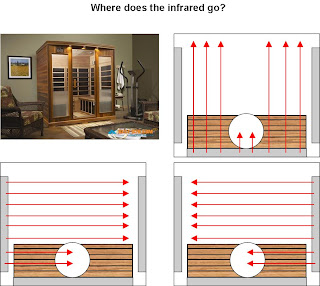3 Key Features That Make An Infrared Sauna Work Best
Thermostat or No Thermostat?
Most saunas have a thermostat and on the surface, this seems like a good convenience. In an infrared sauna, however, it’s a waste. What does a thermostat do? It brings the heat up until the desired temperature is reached and then it shuts off. In an infrared sauna, shutting off the heat means shutting off the infrared. As soon as the infrared shuts off you’re just sitting in a hot, stuffy box.
A better design is to build the sauna so that it naturally reaches a good sauna temperature without a thermostat. If you need it cooler, just open the door a little or a vent. But, whatever you do, don’t shut off the infrared. You should learn to use the sauna by taking a hot sauna for a shorter time, rather than setting the thermostat for a low temperature.
Long Life Saunas have no thermostat. Instead, they are designed to operate at 120-130F, which is the perfect range for near infrared. Without the thermostat, you are getting the full near infrared therapy for the entire length of your sauna session. Do not settle for less.
Reflective walls
Infrared energy travels in a straight line, like light. When you look at the design of any infrared sauna, you can see that no matter how you sit, some of the infrared is going to come out of the emitter and pass right by your body. Take a look at this next picture. It’s a typical carbon panel sauna. Imagine yourself sitting in the sauna, surrounded by carbon panels on your left and right. As you use the sauna, where does this infrared energy around you go?
In most cases, the infrared lands on the wall directly opposite the heater. In the sauna above, it lands on the glass , a wood wall, or on another heater where it is absorbed. None of that infrared ever reaches your body. In the example above, you receive about 20% of the saunas output.
A better design would have that extra infrared energy reflected and reused, rather that be wasted. I realized this early on and created saunas that reflect 97% of the infrared light and heat. When you use a Long Life Near Infrared Sauna, it looks like this:
In a reflective sauna, as much as 90% of the infrared energy reaches your body. That’s one of the reasons these saunas are so much more effective than others.
Cluster Heating
As we learned earlier, you get better tissue penetration with more intense infrared heat in a given surface area. In our saunas, we cluster the heat lamps on one side to maximize the intensity of infrared energy. In addition, this focuses the heat on your midsection. Having tested many designs, this one most easily raises core temperatures which proves it is the best way to achieve deep tissue penetration.
If you liked these tips and want to learn more, you'll find the very best information in " The Ultimate Near Infrared Sauna Guide."
http://www.nearinfraredsauna.com/Infrared_Sauna_Book.html
http://www.nearinfraredsauna.com/Infrared_Sauna_Book.html


